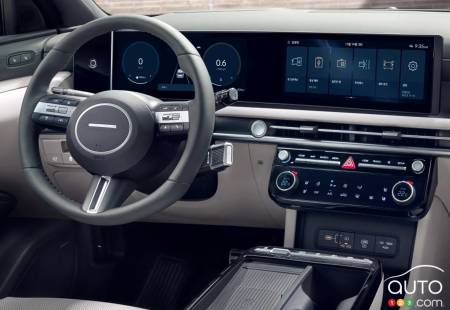Navigating the 2025 Hyundai Tucson Dashboard: A Comprehensive Guide to Symbols and Their Significance
Navigating the 2025 Hyundai Tucson Dashboard: A Comprehensive Guide to Symbols and Their Significance
Introduction
With great pleasure, we will explore the intriguing topic related to Navigating the 2025 Hyundai Tucson Dashboard: A Comprehensive Guide to Symbols and Their Significance. Let’s weave interesting information and offer fresh perspectives to the readers.
Table of Content
Navigating the 2025 Hyundai Tucson Dashboard: A Comprehensive Guide to Symbols and Their Significance

The dashboard of a modern vehicle is a complex tapestry of information, guiding the driver through a myriad of functions and potential issues. The 2025 Hyundai Tucson, with its advanced technology and focus on driver convenience, features an array of symbols that require understanding for a seamless driving experience. This guide aims to demystify these symbols, providing a comprehensive explanation of their meaning and importance.
The Core Symbols: Essential Indicators
- Engine Light (Check Engine Light): This symbol, often depicted as a stylized engine, illuminates when the vehicle’s onboard computer detects a problem with the engine or emissions system. It is crucial to address this issue promptly, as it can indicate a range of problems from a loose gas cap to a more serious engine malfunction.
- Battery Light: This symbol, often depicted as a battery, illuminates when the charging system is not functioning properly. A faulty alternator or battery can lead to a loss of power, potentially stranding the vehicle.
- Brakes Light: This symbol, usually depicted as a brake caliper or a brake disc with an exclamation mark, signifies a problem with the braking system. This could range from low brake fluid to a malfunctioning brake pad sensor. It is imperative to address this issue immediately for safety.
- Tire Pressure Monitoring System (TPMS) Light: This symbol, often depicted as a tire with an exclamation mark, indicates low tire pressure in one or more tires. Maintaining proper tire pressure is essential for fuel efficiency, handling, and tire longevity.
- Anti-lock Braking System (ABS) Light: This symbol, typically depicted as a brake caliper with a wavy line, indicates a malfunction in the ABS system. While the brakes will still function, the ABS system will not be operational, potentially affecting braking performance in emergency situations.
- Traction Control System (TCS) Light: This symbol, often depicted as a car with skidding wheels, indicates a problem with the traction control system. This system helps maintain traction on slippery surfaces, and a malfunction can compromise the vehicle’s stability.
- Airbag Light: This symbol, usually depicted as a stylized airbag, indicates a potential issue with the airbag system. This could range from a faulty sensor to a deployed airbag, requiring immediate attention for safety.
- Oil Pressure Light: This symbol, typically depicted as an oil can with a drop of oil, illuminates when the oil pressure is low. This can indicate a serious engine problem, requiring immediate attention to prevent further damage.
- Temperature Gauge: This gauge, usually depicted as a thermometer, indicates the engine coolant temperature. If the needle rises to the red zone, it signifies overheating, which can lead to engine damage.
Beyond the Basics: Additional Indicators
- Seatbelt Light: This symbol, often depicted as a seatbelt with an exclamation mark, illuminates when a seatbelt is not fastened. This serves as a reminder to buckle up for safety.
- Low Fuel Light: This symbol, usually depicted as a fuel pump with a low fuel level indicator, illuminates when the fuel tank is nearing empty. It is essential to refuel promptly to avoid running out of fuel.
- Headlight Light: This symbol, often depicted as a headlight, illuminates when the headlights are on. It serves as a visual reminder to check the headlight status, particularly at night.
- Fog Light Light: This symbol, usually depicted as a stylized fog lamp, illuminates when the fog lights are activated. It serves as a visual reminder to check the fog light status, particularly in adverse weather conditions.
- High Beam Light: This symbol, typically depicted as a headlight with two beams, illuminates when the high beams are activated. It serves as a visual reminder to check the high beam status, particularly when driving at night.
- Turn Signal Indicator: This symbol, usually depicted as an arrow pointing in the direction of the turn signal, illuminates when the turn signal is activated. It serves as a visual reminder to check the turn signal status and communicate intentions to other drivers.
- Parking Brake Light: This symbol, typically depicted as a handbrake or a parking brake icon, illuminates when the parking brake is engaged. It serves as a visual reminder to check the parking brake status, particularly before driving off.
Beyond the Lights: Understanding the Display
The 2025 Hyundai Tucson dashboard also features a digital display that provides a wealth of information to the driver. This display can include:
- Speedometer: Displays the vehicle’s current speed.
- Odometer: Displays the total mileage driven by the vehicle.
- Trip Meter: Displays the distance traveled on a particular trip.
- Fuel Gauge: Displays the amount of fuel remaining in the tank.
- Gear Indicator: Displays the current gear selected in an automatic transmission.
- Navigation System: Displays directions and guidance for navigation.
- Audio System Information: Displays information about the currently playing audio source.
- Driver Assistance System Status: Displays the status of various driver assistance systems, such as lane departure warning or adaptive cruise control.
Understanding the Importance: Why Dashboard Symbols Matter
The dashboard symbols and displays serve as vital communication tools between the vehicle and the driver. They provide critical information about the vehicle’s performance, potential issues, and driver assistance system status. Recognizing and understanding these symbols is essential for:
- Ensuring Vehicle Safety: Timely detection and response to potential issues like engine problems, brake malfunctions, and airbag problems can prevent accidents and ensure the safety of the driver and passengers.
- Maintaining Vehicle Performance: Identifying and addressing issues early can prevent further damage to the vehicle, ensuring optimal performance and longevity.
- Optimizing Driving Experience: Understanding symbols related to fuel level, tire pressure, and driver assistance systems can help optimize driving efficiency, comfort, and safety.
FAQs: Addressing Common Questions
- What does it mean if the check engine light is flashing? A flashing check engine light indicates a serious problem that requires immediate attention. It is recommended to pull over safely and contact a qualified mechanic.
- What should I do if the battery light comes on? If the battery light illuminates, it is essential to check the battery terminals for corrosion and ensure the alternator is functioning properly. If the problem persists, it is recommended to seek professional assistance.
- What should I do if the brakes light comes on? If the brakes light illuminates, it is crucial to stop safely and check the brake fluid level. If the fluid is low, it should be topped up immediately. If the problem persists, it is recommended to seek professional assistance.
- What should I do if the tire pressure monitoring system light comes on? If the TPMS light illuminates, it indicates low tire pressure in one or more tires. It is recommended to check the tire pressure using a tire pressure gauge and inflate the tires to the recommended pressure.
- What should I do if the anti-lock braking system light comes on? If the ABS light illuminates, it indicates a malfunction in the ABS system. While the brakes will still function, the ABS system will not be operational. It is recommended to seek professional assistance to diagnose and repair the issue.
Tips for Understanding Dashboard Symbols
- Consult the Owner’s Manual: The owner’s manual provides a detailed explanation of all dashboard symbols and their meanings.
- Familiarize Yourself with Common Symbols: Pay attention to common symbols like the engine light, battery light, and brake light, as they are crucial indicators of potential issues.
- Seek Professional Assistance: If you are unsure about the meaning of a particular symbol or if it illuminates, it is best to seek professional assistance from a qualified mechanic.
Conclusion: Navigating the Road with Confidence
The dashboard of the 2025 Hyundai Tucson is a valuable tool for drivers, providing critical information about the vehicle’s performance and potential issues. By understanding the symbols and displays, drivers can ensure a safe and efficient driving experience. Familiarity with these symbols empowers drivers to make informed decisions and take appropriate action when necessary, ultimately contributing to a more enjoyable and safer driving experience.








Closure
Thus, we hope this article has provided valuable insights into Navigating the 2025 Hyundai Tucson Dashboard: A Comprehensive Guide to Symbols and Their Significance. We hope you find this article informative and beneficial. See you in our next article!